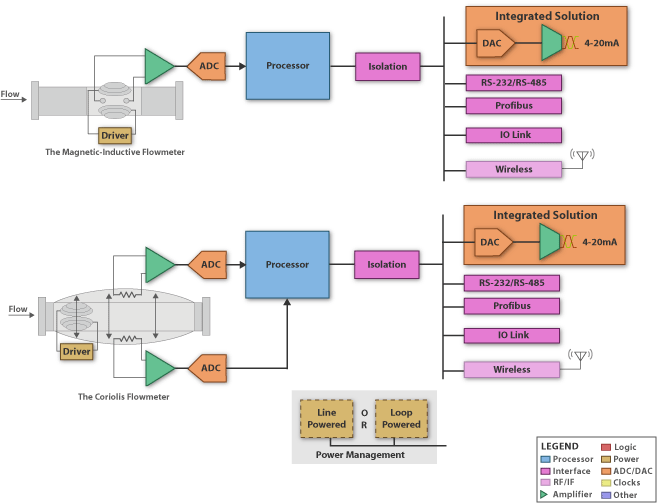
The application requirements of flow measurement in industrial settings varies from low cost to very high precision and fast flow metering found in petrochemical and pharmaceutical plants. The two main methods are Magnetic-Inductive and the Coriolis Flow Meter .
The Electromagnetic Flow Meter consists of a non-ferromagnetic tube wrapped with a magnetic coil. Electrodes in the tube’s inner isolated surface are in contact with the liquid (must be conductive) that flows through the tube. The coils around the pipe generate a magnetic field within the tube. The magnetic field inducts a voltage in the liquid, which is proportional to the speed of the liquid in the tube. This voltage is measured via the electrodes. As the measured voltage is very low, precise low-noise signal conditioning is required.
Coriolis Flow Meter is a popular flow meter that directly measures mass flow rate. The pipe through which the fluid is flowing is made to oscillate at a particular resonant frequency by forcing a strong magnetic field on the pipe. When the fluid starts flowing through the pipe, it is subject to Coriolis force. The oscillatory motion of the pipe superimposes on the linear motion of the fluid exerting twisting forces on the pipe. This twisting is due to Coriolis acceleration acting in opposite directions on either side of the pipe and the fluids resistance to the vertical motion. Sensor electrodes are placed on both the inlet and outlet sides which pick up the time difference caused by this motion. This phase shift due to the twisting forces is a direct measurement of mass flow rate.
Excitation Technique:
The field coils can be excited with AC or DC or Pulsed DC field. Each method has its own pros and cons and depending on the particular application requirements, one method may be favorable over the other. TI provides PWM drivers, high voltage output DACs that can be used to excite the field coils.
Signal Acquisition and Processing:
Low noise instrumentation amplifiers followed by precision ADC is typical of the signal chain path. TI’s high resolution differential ADCs have low power consumption, wide dynamic range and low noise. This can be used to digitize the analog output for high resolution, precision measurements. Multiple channel ADCs with simultaneous sampling architectures enable taking multiple measurements such as temperature, phase, density etc in one shot.
Further calibration routines and algorithms can be run on the ultra low-power MSP430. If more signal processing power is required, one could use the DSP core from TI. The low power DSP cores from TI have a FFT accelerator core that enables computing FFTs in a matter of seconds while drawing very little current. The ultra-low power architecture of the DSP offers superior signal processing power while still being able to be powered off the 4-20mA loop.
Microcontroller:
The Hercules™ Safety MCUs offer an ARM Cortex-R4F based solution and are certified suitable for use in systems that need to achieve IEC61508 SIL-3 safety levels. These MCUs also offer integrated floating point, 12 bit ADCs, motor-control-specific PWMs and encoder inputs via its flexible HET Timer co-processor. Hercules Safety MCUs can also be used to implement scalar and vector-control techniques and support a range of performance requirements.
Interface and Communication:
Traditional analog (4 – 20mA) interface remains the popular choice for industrial control and sensor applications. The other popular protocols include HART, Profibus and IO-Link. TI’s IO-Link interface products have integrated regulators and diagnostic outputs. In addition, wireless options based on IEEE 802.15.4 protocols are becoming more prevalent. TI is committed to provide solutions for both traditional and emerging industrial interfaces.
Power Management:
The Field Transmitter can be powered either off the loop or through a dedicated power line. Line powered transmitters are commonly powered by voltage rails of 12V, or 24V. Loop powered transmitters are powered by the 4-20 mA loop. Such transmitters require extremely low power architectures as the entire solutions has to be powered off the loop. TI provides high efficiency Step Down converters with low quiescent current and low output ripple appropriate for Line and Loop powered transmitters.
Click here for solutions guide
Download Full Block Diagram Below
Advertisement

Learn more about Texas Instruments





